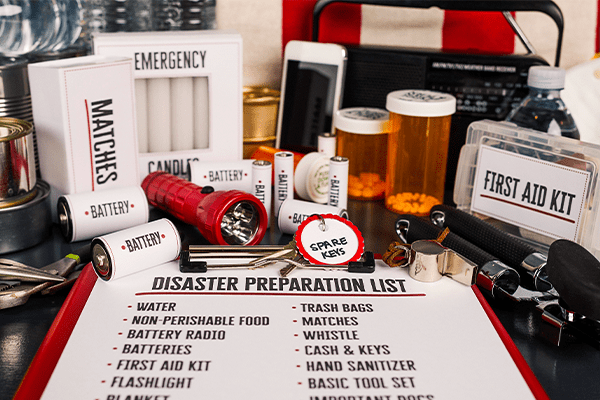
How a Hurricane Can Cost Your Business Without Proper IT Preparedness
A hurricane can cost your business exponentially if your IT environment is not properly prepared.
If a hurricane strikes your business and your IT environment is not prepared properly, you could lose critical pieces of your company. While evacuating your employees and their loved ones can be done, physically taking any IT equipment that fuels your business is more logistically challenging and impractical. For companies that manage on-premise servers and equipment that is difficult to move even with a few days' notice, the unpredictability of an incoming hurricane poses significant threats to your operations and future recovery efforts.
Even if your business is located outside regions that typically experience hurricanes, any severe weather event like a tornado or major winter storm could cost your business exponentially in physical and non-physical losses. In more disastrous cases, businesses close their doors for good due to insurmountable losses. To preserve the functionality and reliability of your business, you must practice proper IT preparedness to protect your company in the event of a hurricane or other natural disaster.

How much can a hurricane cost your business in physical equipment?
Hurricanes and other major weather events can impact businesses of all industries and sizes. The potential physical equipment losses are directly proportionate to your company's scale of operations and how much IT equipment is needed to support it. Depending on the size of your business, you could lose thousands, tens of thousands, or even hundreds of thousands of dollars in physical equipment alone.
“Physical equipment refers to servers, IT equipment, network equipment, external hard drives, expensive electronics, and other pieces of technology that keep your business running,” explains Jason Monroe, Solution Consultant at Bit-Wizards.
On the smaller end of the expense scale, Monroe says low-end computers can cost anywhere from $500 to $1,000. However, more specialized computers and other equipment could rack up as much as $2,000 to $5,000 for each replacement. While losing a single piece of equipment can be a cost that's easier to absorb, the scale of your business can make that price skyrocket.
“It really varies, but at the very least, let's say you go to Walmart for the cheapest deal, and you only have ten employees,” says Monroe. “So, you buy ten $500 computers for your business. Let's say that's the only physical equipment you have. If you leave those computers unprotected during a natural disaster and they get wiped out, you just lost $5,000 in physical equipment.”
How much can non-physical losses cost your business if a hurricane strikes?
An even more costly loss than physical equipment could be your data loss. While pieces of technology can easily be replaced, your company's data can disappear without a trace if you're not properly prepared.
“That data could be critical documents for your business. It could be financial or proprietary data that you've spent years creating,” explains Monroe. “If a storm hits and that data is not properly backed up, it's just gone, and there's nothing you can do to restore it.”
Unfortunately, many business owners learn this lesson the hard way: 25% of businesses fail to reopen after a disaster. That means 1 in 4 businesses close their doors forever. Monroe says that, while it isn't always the sole factor in a company closing its doors, data loss can play a significant role.
“In the worst case scenario where everything goes wrong, data loss could cost you your business,” says Monroe. “And you likely won't even have your existing client base to start over with. If a client needs information and you can't give it to them because you didn't take the proper precautions and lost everything, why would they continue to do business with you? That's another aspect of non-physical losses. Your reputation takes a hit if you can't recover and lose trust in your client base.”
How much can a storm cost your business in downtime?
Monroe says most business owners can calculate their potential losses from downtime based on key performance indicators (KPIs) related to their financial growth, customer experience, processes, and personnel. The formula to estimate your losses is simple, and it can help you recognize the impact of downtime from anywhere between a single day to several months.
“There's an equation out there for this,” he explains. “Let's say you make a million dollars in gross revenue per year. Divide that number by 12 and then divide that number by 30. That will tell you how much money you'll lose each day you're down due to a disaster.”
Even though some essential functions could still be supported during an IT outage, Monroe says you should consider downtime as if your business is closed for all operations.
“If your business is closed and you're not able to work, then you're not making any money,” he says. “If you're a lawyer and you're billing $200 an hour, and let's say you work 10-hour days, you just lost $2,000 if you're down for a day. If that outage continues for the whole week, that's $10,000 lost in combination with significant hits to your reputation with your current and future clients.”

What can you do to prevent financial loss in the event of a hurricane?
Most people think of the cloud as a primary resource for backup storage to ensure that any on-site servers or other devices can be restored after experiencing data loss. While this use is helpful, Monroe says the most beneficial way to use the cloud to prepare for a hurricane is by leveraging it to facilitate and maintain your business operations.
“You can't just have a server backup to the cloud and think you're covered. You need to have your documents and software programs accessible on the cloud at any time by anyone you authorize,” he says. “You and your employees should be using cloud-based storage and process options so you can access documents from your phones, iPads, or laptops if needed.”
Monroe also says your data needs to be backed up somewhere other than on-site. This factor is where the benefit of cloud-based backups especially comes into play.
“Cloud accessible drives, like OneDrive, backup to SharePoint, and then SharePoint backs it up automatically,” he explains. “So, cloud-accessible data and backups are critical. If you have those two things covered, it doesn't matter what you lose in a storm. If your building is washed away, including all your equipment, you can continue to work and not lose revenue as long as you have those two things.”
Juggling the different aspects of IT preparedness is a high-stakes balancing act, and it can be even more difficult for businesses that do not specialize in IT. Without the knowledge needed to prepare your company's IT for an incoming severe weather event, your employees may have to scramble to save whatever equipment and information they can. Hiring a Managed IT Services (MITS) provider like Bit-Wizards can help prepare your business for a hurricane and ensure you don't lose money or sleep from IT worries.
“It's a turnkey solution,” says Monroe. “Bit-Wizards will come in, and over the course of our onboarding, we'll take your business and transform it from a local-only business to a cloud business.”
Monroe says that's the most significant part of a business continuity and disaster recovery plan that will help preserve your company's IT without requiring much time, effort, or training of your team members.
“You don't have to worry about setting anything up correctly or which employees get access to what,” says Monroe. “We'll set everything up for you and train your team to use everything. We'll also help you build a business continuity and disaster recovery plan that includes protecting your physical equipment, working remotely, and having proper backups.”
Ready to ensure that your business' IT is properly prepared so you don't lose money when a hurricane strikes? Learn more about our services and get in touch.